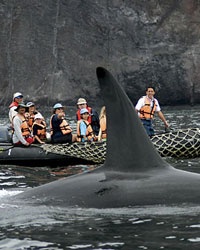 Courtesy of Linblad Courtesy of Linblad
Whether it’s building houses in Jordan or meeting the feathered residents of Antarctica’s Penguin Island, these dream journeys are guaranteed to make a difference in your life, and the lives of those you help along the way.
Courtesy of Linblad Courtesy of Linblad
Whether it’s building houses in Jordan or meeting the feathered residents of Antarctica’s Penguin Island, these dream journeys are guaranteed to make a difference in your life, and the lives of those you help along the way.
Sustainable travel. Ecotourism. Fund-raising expeditions. Educational tours. Voluntourism.
The lexicon of travel is expanding as quickly as the world is shrinking. For many, it is no longer enough to return home with a Turkish carpet or tales of an exquisite atoll. Travelers still want to explore Chile or the Loire in style, but they also want a deeper experience, and one that doesn’t leave a footprint, carbon or otherwise. In the post-9/11 world, travelers want to make transformations of their own.
A range of organizations are answering that need, including luxury outfitters like Butterfield & Robinson, environmental watchdogs such as the Sierra Club, and new groups like Cross-Cultural Solutions (CCS), which places volunteers in 12 countries. As with other vacation packages, there is staff to take care of the details—arranging airport transfers, setting up accommodations (a converted riad, a Maori lodge, a stateroom on an Amazon sloop), and coordinating work assignments.
Whatever these trips might cost, all of them give back—to the travelers themselves as well as to the communities they visit. Debby and Tom Glassanos of Pleasanton, California, spent three weeks in Morocco with CCS where Tom, a Silicon Valley executive, worked with local women to increase their computer skills. Now, long after the couple’s return to the United States, he continues to share his expertise with his old students in a stream of e-mail exchanges. And interior designer Joe Naham and his partner, Jeffrey Fields, carried away from their trip to Costa Rica a lasting impression of the camaraderie that can develop between "voluntour" travelers of disparate backgrounds. Their group—including a financier, a CNN anchor, and a coffeehouse owner—discovered shared interests along with the new bond of their shared experience abroad.
Volunteers also describe the rewards of contributing beyond writing a check, although the dollars these programs provide to communities and causes are significant and often crucial. The itineraries that follow have the potential to make a difference in both your world, and the world.
— Ann Armbruster, Christine Adjudua, Jennifer Bain, Geraldine Campbell, Ilan Greenberg, Julia Houlihan, Jessica Merril, Suzanne Mozes, Benjamin Skinner, Bree Sposato, Wing Sze Tang, and Jennifer Welbel
Alaska
Newfoundland
New Orleans
New York City
Yellowstone and Grand Teton National Parks
Armenia
Bosnia and Herzegovina
Ireland
Lapland
North Sea
Portugal
Western Europe
Western Russia
Bahamas
St. John
Galápagos
Guatemala/Antigua
Guatemala/Tikal
Mexico
Peru/Machu Picchu
Peru/Cuzco
Peru/San Pedro
Cook Islands
Fiji
India
Nepal
Nepal and Tibet
Thailand
Thailand/Ban Non Wat
Vietnam
Botswana
Gabon
Jordan
Kenya
Namibia
South Africa/Gansbaai
South Africa/Shark Diving
Tanzania
Antarctica
New Zealand
GlobalGiving This not-for-profit coordinates online donations for more than 520 charity projects worldwide. Visitors can search by region or topic. Eighty-five to 90 percent of your contribution is put to use within two months .
Responsible Travel RT has created a socially sensitive directory of trips—organized by location, activity, and users’ reviews. The site’s staff regularly reevaluates all destinations to ensure that they meet company standards .
Sustainable Travel International Check out the Colorado-based company’s Eco-Directory for 250 tour operators, hoteliers, and transport services, all dedicated to making the tourism industry more socially effective .
The Travel Foundation Though you can’t book eco-trips through the company’s Web site, visitors can download destination-specific guides addressing environmental concerns, and tips on how to maximize your experience while minimizing your imprint .—Julia Houlihan
With 70 percent of cruises traveling to biodiversity hot spots, from Galápagos to Molokai, there are concerns about the ships’ impact on fragile environments. As an estimated 14.2 million passengers are expected on board in 2010 (a 49 percent jump since 1998), the cruise industry is working to become more eco-friendly. According to Steve Collins, director of environmental programs for the Cruise Lines International Association, the U.S. Coast Guard routinely monitors ships’ discharges and emissions, but now cruise lines are going further than the law requires. Many lines are switching to gas turbine engines to reduce emissions, and others are adopting dockside electric shore power, which allows ships to plug into an outside source of electricity while in port, reducing pollution from onboard generators. When the technology was first introduced in Seattle, emissions from docked ships were reduced by 30 percent. Some vessels have installed advanced wastewater-treatment systems and are rerouting their itineraries to avoid eco-sensitive areas such as coral reefs.
Still, these efforts are not universal, so it’s up to travelers to do their research. Collins recommends checking out each company’s ecological policies on its Web site or contacting its environmental department. —Wing Sze Tang